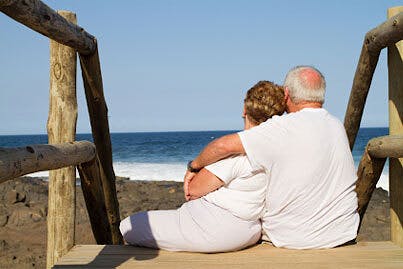
Travel Tips from Dr Ruth Handford ¶
Long standing and recurrent low back pain is all too common in people of all age groups. Often occupational stresses can exacerbate it, and a holiday can be just the relief that’s needed. It’s well worth planning ahead before travelling, to try to ensure the journey itself does not make your back problem flare up or deteriorate.
Give some thought to the following tips to make your travel and holiday more comfortable.
Where To Go? ¶
Depending on the severity of your back problem, you may want to consider the destination you choose carefully.
The local terrain, accessibility to the accommodation you choose, and how long you will need to travel are all factors that could turn a relaxing holiday in to a painful waste of money.
How far are you able to travel comfortably? A shorter journey may lead to less pain and stiffness in some back conditions.
How to Get There ¶
When considering your destination, think about the best mode of transport for you. Are you more comfortable in a car, able to stop frequently? Or would a train be ideal – able to walk around and change position whilst reaching your destination more quickly.
Consider whether a cruise type holiday may be a better way to visit far flung destinations than by air – cruise ships offer the opportunity to stay mobile, use massage and pool facilities, and lay flat when required. Air travel may be the quickest way to get to your chosen destination, and reducing the length of your journey could be key.
Tips for Comfortable Air Travel ¶
So you need to fly to get to where you’re going – great. Just a few things to think about before you board that plane.
Think about requesting your seat allocation prior to travelling – being in an aisle seat may make it easier to move about on the aircraft which can help reduce spasm.
Think about whether investing in an upgrade may be worthwhile – a reclining seat with more leg room and space to stretch out in could be well worth the money if it means you arrive at your destination comfortable and relaxed.
Schedule your flights carefully. It may be that boarding a plane and navigating an airport departures lounge are experiences best kept to a minimum, but for some people, breaking up a long haul journey into two or three legs may offer the opportunity to stay more mobile at the same time as experiencing multiple destinations.
Speak to your airline before you travel to ensure that any assistance you may require is arranged in advance. Even if you do not usually need a wheelchair, it may be useful at the airport to help manage lengthy queues or long walks through the building more comfortably.
Make sure you think carefully about what you want to take in your hand luggage. Try to minimise the weight you will carry around with you, and choose a bag that is comfortable to carry, like a rucksack or something with wheels you can pull. Remember to ask for assistance when lifting your hand luggage in to and out of the overhead lockers on the flight – lifting and twisting at the same time is a great combination to make a vulnerable back much worse.
Ensure you have suitcases that can be wheeled around rather than carried, and preferably the kind that glide rather than need pulling along.
Pain Relief and Medication ¶
Make sure you take any prescribed medication for your back with you, in it’s original packaging. Take a copy of your repeat prescription from your doctor too.
If you are on strong painkillers, it is worth checking that they are permitted to take into the country you are travelling to.
It is usually fine to take enough prescription medication with you for the duration of your trip, as long as it is in original packaging and you let customs know before you pass through. Always check first though, and if in doubt, ask your GP for a letter supporting your need to take this medication during your trip.
Similarly, make sure you time your pain relief so that you are taking it an appropriate time before you travel, such that it will work best while you are on the go. If you have any stronger pain killers that you use ‘just in case’ things get worse, have some with you on your journey.
If you have benefitted from muscle relaxant medication like diazepam in the past for your back problems, see your GP before you travel and get a small supply to take with you on your trip in case you really need it.
Alternative Methods of Easing Back Pain ¶
Some people find that a hot water bottle can be helpful for back pain, but this can be tricky to organise on a long journey! Consider trying an adhesive heat pad, which are readily available from supermarkets and chemists. Alternatively, if you find cold applications more useful, take Ziploc sandwich bags on your flight – the cabin crew should be able to fill them with ice for you to use if you need to.
Support cushions and pads are also worth taking with you if you have used them in the past with good effect. Supporting the natural curve in the lower back whilst sitting upright for long periods may help to reduce spasm.
Similarly, staying well hydrated can reduce the chance of muscles cramping up, so keep drinking plenty of non-alcoholic fluids before and during your journey.
Move around regularly during long journeys – a short walk every hour and some simple stretches for you legs and back can be invaluable to keep your back comfortable.
TENS machines are readily and cheaply available at chemists now, and are often used by physiotherapists to help with chronic pain. Make sure you practice using your TENS machine before your holiday if you choose to try one, and do not put it on until you are through the security check at an airport or you may have to remove it at very short notice!
Don’t forget that long haul travel can be stressful, so time your trips to be conducive to being well rested and prepared. Give yourself plenty of time to navigate busy motorways, car parks, and airports. Make sure you have relaxing things to occupy you on your journey, like music, a book, or other hobby.
Destination Considerations ¶
If you are staying at a hotel, it is worth contacting them in advance to request a firm mattress if this helps your back stay comfortable.
Also make sure you think about whether the accommodation has a lift or if you are going to need to climb a lot of stairs every time you leave your room.
Consider the location of your accommodation – can you get transport easily or do you have to walk some distance to reach amenities? Daily tasks like getting milk or finding a restaurant could become prohibitive should your symptoms flare up.
Like with many chronic conditions, you as the patient are the expert, and by just thinking around a few eventualities and scenarios you can help to prevent your condition from spoiling your trip. Happy travels!
Always consult your own doctor before travelling ¶
These travel tips are intended to provide general information to those with chronic back pain. They do not replace a visit to your doctor. If you are planning a holiday, you should consult your doctor to ensure that you are fit to travel and discuss any specific health requirements you may have.
About Dr Ruth Handford ¶
Dr Ruth Handford is a GP with over 10 years' experience of working in both hospital and primary care. She is particularly interested in caring for the elderly in the community, child health, and family planning. Ruth lives and works in a rural community, and is kept very busy by her job and young family.
Travel Insurance for Chronic Back Pain ¶
The Foreign and Commonwealth Office recommend that you have travel insurance in place every time you travel abroad. Make sure that your insurers are aware that you have back pain and ensure that your travel insurance provides cover for this; as well any other medical conditions you may have.
